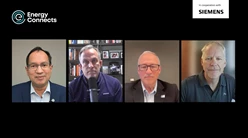Wind, Solar Credits Face Shorter Phase-Out in New Tax Bill
(Bloomberg) -- Key tax incentives for US wind and solar projects would face a more aggressive phase-out in the Senate’s latest version of President Donald Trump’s spending package.
The tweak, which follows pushback by Trump on the Inflation Reduction Act credits, would sharply limit the number of solar and wind farms that qualify for incentives, appeasing opponents while risking the ire of moderate members who argued for a slower phase-out.
Under the new version of the $4.2 trillion tax and spending package released late Friday, wind and solar projects would need to be up and running by the end of 2027 to receive a pair of lucrative incentives for clean energy production.
The initial version released by the Senate’s tax-writing committee simply required projects to start construction by the end of 2025 to get the incentives’ full value.
“This is a huge problem for wind and solar developers, who thought they would have at least four years to finish projects that started in 2025,” said James Lucier, managing director at research group Capital Alpha Partners.
If it becomes law, the change could be a blow to companies such as NextEra Energy Inc., the biggest US developer of wind and solar projects, which has an inventory of projects that qualified as starting construction in 2025, Lucier said.
The legislation also adds a new tax on wind and solar projects that don’t meet strict restrictions against the use of Chinese materials, as well as adds the production of coal used in steel making to an existing tax credit for clean energy technology such as wind turbines and solar panels.
A residential energy credit that has benefitted solar-leasing companies such as Sunrun Inc., would expire at the end of 2025 in the current legislation. But it restores access to a separate investment tax credit until the end of 2027 that an earlier version of the bill removed, Charlotte Jenkins, a vice president at research firm Capstone LLC, said in an email. Still, the tweak wasn’t enough to stop the solar industry from slamming the bill.
“Any senator who votes for this bill is voting for higher energy prices, a weaker economy, and a less secure America,” the Solar Energy Industries Association said in a statement. “And they’ll have to answer for it when families open their utility bills, when workers lose their paychecks, and when voters head to the polls.“
The bill does include a longer phase-out of a tax credit for hydrogen production used by companies such as Plug Power Inc. While the initial version of the legislation ended the credit after this year, the new version allows it to remain until 2028.
Other tweaks made in the new version of the bill includes a quicker end to a popular $7,500 consumer tax credit for electric vehicles.
While the earlier proposal would have ended the incentive at the end of this year for most EV sales, the new version terminates the credit after September 30, 2025. Tax credits for the purchase of used and commercial electric vehicles would end at the same time.
The tweaks reflect House Republican resistance to the more generous timetables. House Majority Leader Steve Scalise said Thursday the House will need to reverse the Senate’s move to extend a slew of clean energy tax credits.
“We had a lot of back and forth over getting that language right to keep it tight,” Scalise said. Trump “is where we are, if not more aggressive, in getting rid of it,” he said.
(Updates with new details in eighth paragraph.)
©2025 Bloomberg L.P.





